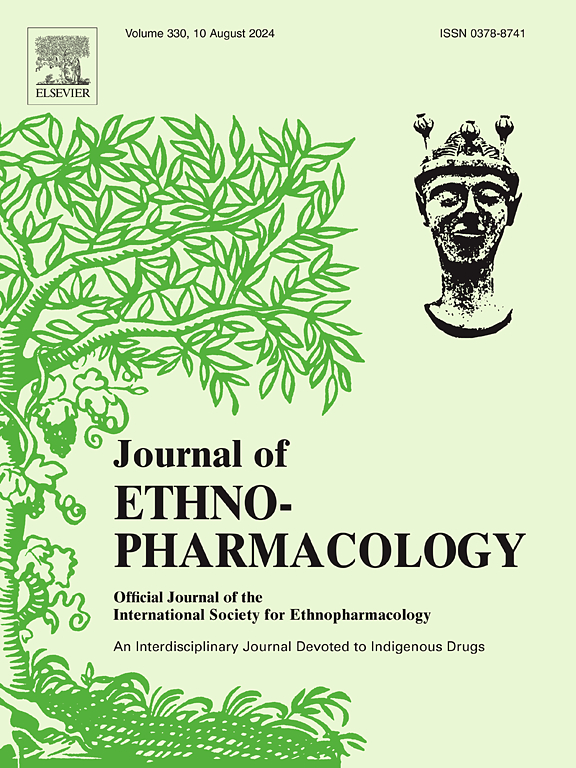Exploring the potential protective mechanism of Gastrodia elata Blume in Parkinson's disease using LC-MS/MS-based striatal metabolomics
IF 5.4
2区 医学
Q1 CHEMISTRY, MEDICINAL
引用次数: 0
Abstract
Ethnopharmacological relevance
Gastrodia elata Blume (GEB), a herbaceous plant from the Orchidaceae family, is the core ingredient of the classic traditional Chinese medicine formula Tianma Gouteng Yin. Its dried tubers have been used in medicine since ancient times, with records dating back to the "Shennong Bencao Jing," and are commonly employed in the treatment of limb numbness and convulsions, boasting a medicinal history of over 1800 years. However, no studies have yet focused on the changes in differential metabolites in the striatum after GEB treatment.
Aim of the study
This study aimed to evaluate the protective effects of GEB on MPTP-induced Parkinson's disease (PD) in mice and to explore its potential mechanisms.
Materials and methods
Mice were randomly divided into a control group, a model group, and GEB treatment groups (100, 200, and 300 mg/kg). After 14 days of GEB pretreatment, a sub-acute PD model was induced by intraperitoneal injection of MPTP (30 mg/kg) once daily for 7 consecutive days. The potential of GEB to improve motor behavior in PD mice was evaluated using gait analysis (GA) and the pole test. Enzyme-linked immunosorbent assay was used to measure interleukin-6 (IL-6), interleukin-1 beta (IL-1β), and tumor necrosis factor-alpha (TNF-α) levels in the striatum of PD mice. The effects of GEB on substantia nigra damage were assessed by hematoxylin and eosin staining (HE) and immunohistochemistry. Lastly, the therapeutic effects and potential mechanisms of GEB on MPTP-induced PD mice through striatal metabolomics analysis were investigated.
Results
A total of 402 compounds were identified in the GEB ethanol extract, with gastrodin, parishins A, B, C, and E, and 4-hydroxybenzyl alcohol being the major components. These were quantified by HPLC at 2.47 %, 2.04 %, 1.25 %, 0.33 %, 1.14 %, and 2.88 %, respectively. GEB improved the propulsive index and duty cycle of the gait index, reduced climbing time, and inhibited the elevation of inflammatory factors such as IL-1β, IL-6, and TNF-α in the striatum. GEB ameliorated neurodegeneration in the substantia nigra pars compacta and alleviated motor impairments in PD model mice.
Furthermore, striatal metabolomics analysis showed that GEB treatment improved various metabolic pathways, including glycerophospholipid, sphingolipid, tyrosine, arachidonic acid, and arginine and proline.
Conclusions
GEB extract demonstrated positive ameliorative effects on PD by inhibiting inflammatory responses, ameliorating neuronal damage, and modulating lipid metabolic pathways, and possibly being an ideal candidate for the development of functional foods for PD.

利用LC-MS/MS-based纹状体代谢组学研究天麻对帕金森病的潜在保护机制
民族药理学相关性:天麻勾藤饮是一种兰科草本植物,是中药经典配方天麻勾藤饮的核心成分。它的干块茎自古以来就被用于医学,记载可以追溯到“神农本草经”,通常用于治疗肢体麻木和抽搐,拥有1800多年的药用历史。然而,尚未有研究关注GEB治疗后纹状体中差异代谢物的变化。研究目的:本研究旨在评价GEB对mptp诱导的小鼠帕金森病(PD)的保护作用,并探讨其可能的机制。材料和方法:将小鼠随机分为对照组、模型组和GEB治疗组(100、200、300 mg/kg)。GEB预处理14 d后,腹腔注射MPTP (30 mg/kg) 1次,连续7 d,建立亚急性PD模型。采用步态分析(GA)和极试验评价GEB改善PD小鼠运动行为的潜力。采用酶联免疫吸附法测定PD小鼠纹状体中白细胞介素-6 (IL-6)、白细胞介素-1β (IL-1β)和肿瘤坏死因子-α (TNF-α)水平。采用苏木精和伊红染色(HE)及免疫组化评价GEB对大鼠黑质损伤的影响。最后,通过纹状体代谢组学分析,探讨GEB对mptp诱导的PD小鼠的治疗作用及可能的机制。结果:共鉴定出402种化合物,主要成分为天麻素、天麻素A、天麻素B、天麻素C、天麻素E和4-羟基苄基醇。高效液相色谱法分别为2.47%、2.04%、1.25%、0.33%、1.14%和2.88%。GEB提高了推进指数和步态指数占空比,缩短了攀爬时间,抑制纹状体中IL-1β、IL-6、TNF-α等炎症因子的升高。GEB可改善PD模型小鼠致密黑质神经退行性变,减轻运动障碍。此外,纹状体代谢组学分析显示,GEB处理改善了多种代谢途径,包括甘油磷脂、鞘脂、酪氨酸、花生四烯酸、精氨酸和脯氨酸。结论:GEB提取物通过抑制炎症反应、改善神经元损伤、调节脂质代谢途径等对PD有积极的改善作用,可能是开发PD功能食品的理想候选物。
本文章由计算机程序翻译,如有差异,请以英文原文为准。
求助全文
约1分钟内获得全文
求助全文
来源期刊

Journal of ethnopharmacology
医学-全科医学与补充医学
CiteScore
10.30
自引率
5.60%
发文量
967
审稿时长
77 days
期刊介绍:
The Journal of Ethnopharmacology is dedicated to the exchange of information and understandings about people''s use of plants, fungi, animals, microorganisms and minerals and their biological and pharmacological effects based on the principles established through international conventions. Early people confronted with illness and disease, discovered a wealth of useful therapeutic agents in the plant and animal kingdoms. The empirical knowledge of these medicinal substances and their toxic potential was passed on by oral tradition and sometimes recorded in herbals and other texts on materia medica. Many valuable drugs of today (e.g., atropine, ephedrine, tubocurarine, digoxin, reserpine) came into use through the study of indigenous remedies. Chemists continue to use plant-derived drugs (e.g., morphine, taxol, physostigmine, quinidine, emetine) as prototypes in their attempts to develop more effective and less toxic medicinals.
 求助内容:
求助内容: 应助结果提醒方式:
应助结果提醒方式:


